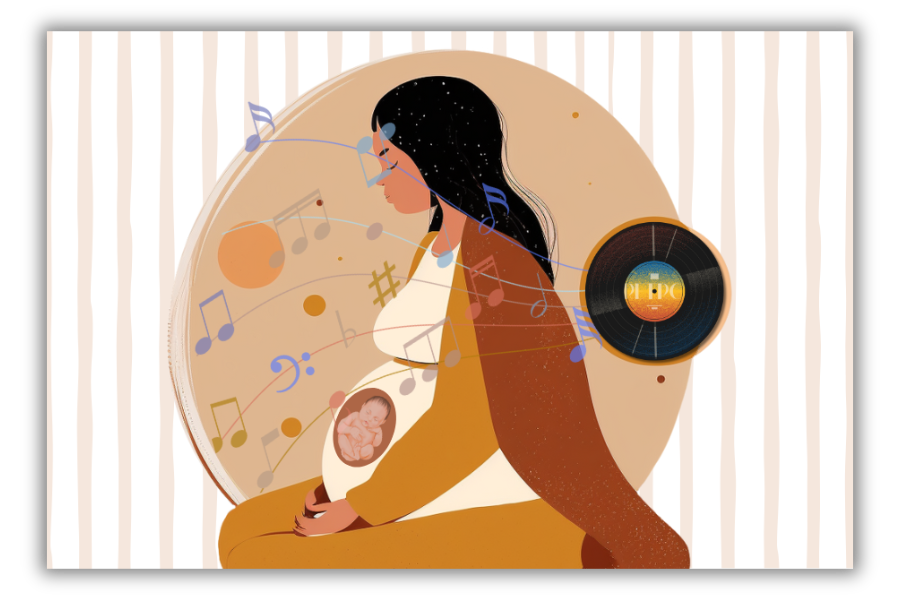Why is music so central to our lives? We now know from embryology that by the second trimester of pregnancy - that is as early as the 17th week - an elementary form of the ear is already taking shape. So at this very early stage the fetus begins to respond to vibration, in general, as well as to the sound of the mother’s heartbeat, her breathing, her voice. It is all distilled in the pithy insight “We heard long before we could see.”
The sense of hearing, the first of our sensory organs to develop, is foundational to so much of who we become as human beings. And, at the other end of the life cycle, patients in a coma have been known to respond by arm twitches or fluttering eyelids to a familiar sound. Indeed, all through life we are part of a vast vibrating universe, affected as we are by changes in the weather, day and night. It all starts with the heartbeat and rhythm of our mother’s breathing heard in utero – something that is later transformed into the beating of a drum and the many other rhythms of music.
This kind of memory lays the foundation for the acquisition of language and all its speech inflections. It also is critical in establishing neural pathways for the establishment of a spatiotemporal sense, a sense of causality—”Oh that sound came from over there.” For that very reason echolocation would otherwise be impossible for the blind.
Characterized by Judy Collins as “truly powerful and fascinating, “ Ellen Mannes’s 2011 book The Power of Music opens with a thoroughly riveting chapter, “Feeling the Sound.” Among other things, she singles out “the groundbreaking research” of Sheila Woodward. As part of her doctoral studies at the University of Cape Town, Woodward worked with the Institute of Maritime Technology to develop a tiny underwater microphone that could be placed in the uterus. This hydrophone detected the rhythmic sound of blood rushing through the uterine artery as well as the sound of external singing. In short, “a landscape of musical sound” was found to surround the fetus –prompted by the playing of a Bach Brandenburg Concerto, the singing of “Mary Had a Little Lamb,” and more. The fetus was shown to respond to sounds as indicated by an elevated heart rate, echoing the mother’s response.
For full details, here is a link Woodward’s 1993 doctoral dissertation, “The transmission of music into the human uterus and the response to music of the human fetus and neonate”:
https://open.uct.ac.za/items/ebf41044-bbfd-4c51-9945-dcd61c0535e8
Fast forward to the present, it is worth noting that Sheila Woodward, after serving on the faculties of the University of Southern California and the University of South Florida, now directs an online Master of Music in Music Education program at East Washington University, a public university in Cheney, Washington .
Alexandra Lamont, Professor of Music Psychology at Keele University in the U.K, has published widely in the area of postnatal musical experience. But there is one article that is especially relevant here. Its title is “Infants’ Preferences for Familiar and Unfamiliar Music: A Socio-Cultural Study” (paper read at Society for Music Perception and Cognition at Kingston, Ontario, 9 August 2001), and is cited in Daniel J. Levitin’s, This Is Your Brain on Music: The Science of a Human Obsession (New York: Plume, 2007), 223–225.
Using a technique known as ”the conditioned head-turning procedure,” , she exposed babies to pieces of music chosen by the mother while still in the womb. Mother and child were placed midway between two loudspeakers. Pieces singled out ranged from classical (Mozart and Vivaldi) to Top 40, to reggae and world beat. From birth until the child’s first birthday, the baby was not exposed to the same music. Over one year later, all of the babies displayed significant preferences for the pieces they heard in the womb over similar pieces to which they had never been exposed. A control group tested with the same set of pieces displayed no clear preference. The key point is that they looked longer at the speaker playing the music that they had heard in utero than at the speaker playing similar but novel music. Levitin cites the example of a boy who had heard UB40’s reggae track “Many Rivers to Cross” played to a neonate which was then heard again a year later along with “Stop Loving You” by Freddie Mc Gregor. The infant would look longer at the speaker playing the familiar music.
So what can we conclude from all of the above? What is important for us to know either about how music shaped us as infants and/or as parents who want our children to be exposed to and reap the benefits of music before they’re born? Actually, there are no easy answers to these questions. Replicating the studies cited above and also drawing upon more diverse populations would yield more definitive results. That said, the extent to which fetal memory alone can define musical preferences is very hard to quantify. From early on, a child’s peer group is very likely to exert a strong influence, growing even stronger during the teenage years.
For those interested in more recent and more holistic research by Alexandra Lamont, a good place to start is:
How Does Music Define Us ? --2023 lecture at Keele University
We close with an invitation to all mothers and grandmothers out there to share any prenatal and postnatal musical experiences they have had that confirm, or maybe even refute, the research done by people by like Sheila Woodward and Alexandra Lamont.
Copyright 2025 by Joshua Berrett. All Rights Reserved.
Please consider making a tax-deductible donation directly to the Ageless Mind Project (AMP), a 501(c)3 nonprofit. To donate, click on the button below.





I have noticed while listening to solo piano music that different solo notes appear in as many as 3 different spots in left and right ears.